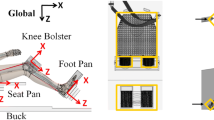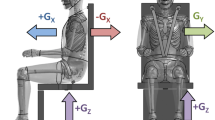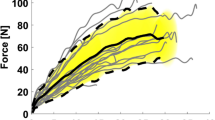Abstract
Validation is a critical step in finite element model (FEM) development. This study focuses on the validation of the Global Human Body Models Consortium full body average male occupant FEM in five localized loading regimes—a chest impact, a shoulder impact, a thoracoabdominal impact, an abdominal impact, and a pelvic impact. Force and deflection outputs from the model were compared to experimental traces and corridors scaled to the 50th percentile male. Predicted fractures and injury severity measures were compared to evaluate the model’s injury prediction capabilities. The methods of ISO/TS 18571 were used to quantitatively assess the fit of model outputs to experimental force and deflection traces. The model produced peak chest, shoulder, thoracoabdominal, abdominal, and pelvis forces of 4.8, 3.3, 4.5, 5.1, and 13.0 kN compared to 4.3, 3.2, 4.0, 4.0, and 10.3 kN in the experiments, respectively. The model predicted rib and pelvic fractures related to Abbreviated Injury Scale scores within the ranges found experimentally all cases except the abdominal impact. ISO/TS 18571 scores for the impacts studied had a mean score of 0.73 with a range of 0.57–0.83. Well-validated FEMs are important tools used by engineers in advancing occupant safety.







Similar content being viewed by others
References
Barbat, S., Y. Fu, Z. Zhan, R. J. Yang, and C. Gehre. Objective rating metric for dynamic systems. In: Enhanced Safety of Vehicles, Seoul, Republic of Korea, 2013.
Beillas, P., Y. Lafon, and F. W. Smith. The effects of posture and subject-to-subject variations on the position, shape and volume of abdominal and thoracic organs. Stapp Car Crash J. 53:127–154, 2009.
Bouquet, R., M. Ramet, F. Bermond, Y. Caire, Y. Talantikite, S. Robin, and E. Voiglio. Pelvis human response to lateral impact. In: 16th International Technical Conference on the Enhanced Safety of Vehicles, Windsor, ON, Canada, 1998, pp. 1665–1686.
Bouquet, R., M. Ramet, F. Bermond, and D. Cesari. Thoracic and pelvis human response to impact. In: Proceedings: International Technical Conference on the Enhanced Safety of Vehicles, 1995, pp. 100–109.
Budyn, E., T. Hoc, and J. Jonvaux. Fracture strength assessment and aging signs detection in human cortical bone using an X-FEM multiple scale approach. Comput. Mech. 42:579–591, 2008.
DeWit, J. A., and D. S. Cronin. Cervical spine segment finite element model for traumatic injury prediction. J. Mech. Behav. Biomed. Mater. 10:138–150, 2012.
Eppinger, R. H. Prediction of thoracic injuries using measurable experimental parameters. In: Proceedings of the Sixth International Technical Conference on the Enhanced Safety of Vehicles (ESV), 1976.
Fice, J. B., D. S. Cronin, and M. B. Panzer. Cervical spine model to predict capsular ligament response in rear impact. Ann. Biomed. Eng. 39:2152–2162, 2011.
Gayzik, F. S., J. J. Hoth, M. Daly, J. W. Meredith, and J. D. Stitzel. A finite element-based injury metric for pulmonary contusion: investigation of candidate metrics through correlation with computed tomography. Stapp Car Crash J. 51:189–209, 2007.
Gayzik, F. S., D. M. Moreno, C. P. Geer, S. D. Wuertzer, R. S. Martin, and J. D. Stitzel. Development of a full body cad dataset for computational modeling: a multi-modality approach. Ann. Biomed. Eng. 39:2568–2583, 2011.
Gayzik, F. S., M. Yu, K. A. Danelson, D. E. Slice, and J. D. Stitzel. Quantification of age-related change of the human rib cage through geometric morphometrics. J. Biomech. 41:1545–1554, 2008.
GHBMC. Ghbmc M50 Users Manual, 2014.
Hardy, W. N., L. W. Schneider, and S. W. Rouhana. Abdominal impact response to rigid-bar, seatbelt, and airbag loading. Stapp Car Crash J. 45:1–32, 2001.
Hayes, A. R., F. S. Gayzik, D. P. Moreno, R. S. Martin, and J. D. Stitzel. Comparison of organ location, morphology, and rib coverage of a midsized male in the supine and seated positions. Comput. Math. Methods Med. 2013:419821, 2013.
Hayes, A. R., N. A. Vavalle, D. P. Moreno, J. D. Stitzel, and F. S. Gayzik. Validation of simulated chestband data in frontal and lateral loading using a human body finite element model. Traffic Inj. Prev. 15:181–186, 2014.
Hertz, E. A note on the head injury criterion (Hic) as a predictor of the risk of skull fracture. In: Proceedings: Association for the Advancement of Automotive Medicine Annual Conference, Vol. 37, 1993, pp. 303–312.
ISO. Iso Tr 9790: Road Vehicles—Anthropomorphic Side Impact Dummy—Lateral Impact Response Requirements to Assess the Biofidelity of the Dummy, 1999.
Kim, Y. H., J. E. Kim, and A. W. Eberhardt. A new cortical thickness mapping method with application to an in vivo finite element model. Comput. Methods Biomech. Biomed. Eng. 17:997–1001, 2012.
Kim, Y. H., J. E. Kim, and A. Eberhardt, Finite element simulation of pelvic fractures in side impacts. In: ASME Summer Bioengineering Conference, Fajardo, PR, 2012.
Koh, S. W., J. M. Cavanaugh, M. J. Mason, S. A. Petersen, D. R. Marth, S. W. Rouhana, and J. H. Bolte. Shoulder injury and response due to lateral glenohumeral joint impact: an analysis of combined data. Stapp Car Crash J. 49:291–322, 2005.
Kroell, C., D. Schneider, and A. Nahum. Impact tolerance and response of the human thorax. Stapp Car Crash J. 15:710851, 1971.
Kroell, C. K., D. C. Schneider, and A. M. Nahum. Impact Tolerance and Response of the Human Thorax Ii, Vol. 741187, SAE Technical Paper, 1974.
Kuppa, S., J. Wang, M. Haffner, and R. Eppinger. Lower extremity injuries and associated injury criteria. In: 17th ESV Conference, Paper, 2001.
Lebarbé, M., and P. Petit. New biofidelity targets for the thorax of a 50th percentile adult male in frontal impact. In: 2012 International IRCOBI Conference on the Biomechanics of Impact. Dublin, Ireland, 2012, pp. 856–870.
Li, Z., M. W. Kindig, J. R. Kerrigan, C. D. Untaroiu, D. Subit, J. R. Crandall, and R. W. Kent. Rib fractures under anterior-posterior dynamic loads: experimental and finite-element study. J. Biomech. 43:228–234, 2010.
Li, Z., M. W. Kindig, D. Subit, and R. W. Kent. Influence of mesh density, cortical thickness and material properties on human rib fracture prediction. Med. Eng. Phys. 32:998–1008, 2010.
Mao, H., L. Zhang, B. Jiang, V. V. Genthikatti, X. Jin, F. Zhu, R. Makwana, A. Gill, G. Jandir, and A. Singh. Development of a finite element human head model partially validated with thirty five experimental cases. J. Biomech. Eng. 135:111002, 2013.
Mattucci, S. F., J. A. Moulton, N. Chandrashekar, and D. S. Cronin. strain rate dependent properties of younger human cervical spine ligaments. J. Mech. Behav. Biomed. Mater. 10:216–226, 2012.
Mattucci, S. F., J. A. Moulton, N. Chandrashekar, and D. S. Cronin. Strain rate dependent properties of human craniovertebral ligaments. J. Mech. Behav. Biomed. Mater. 23:71–79, 2013.
Mertz, H. J., P. Prasad, and A. L. Irwin. Injury Risk Curves for Children and Adults in Frontal and Rear Collisions. SAE Technical Paper, 1997.
Park, G., T. Kim, J. R. Crandall, C. Arregui-Dalmases, and J. Luzon-Narro. Comparison of kinematics of Ghbmc to Pmhs on the side impact condition. In: International Research Council on Biomechanics of Injury, Gothenburg, Sweden, 2013.
SAE. Instrumentation for Impact Test—Part 1: Electronic Instrumentation, Vol. J211/1. Warrendale, PA: Society of Automotive Engineers, 2014.
Shin, J., and C. Untaroiu. Biomechanical and injury response of human foot and ankle under complex loading. J. Biomech. Eng. 135:101008, 2013.
Soni, A., and P. Beillas. Modelling hollow organs for impact conditions: a simplified case study. Comput. Methods Biomech. Biomed. Eng. 18:730–739, 2015.
Stitzel, J. D., P. D. Kilgo, A. A. Weaver, R. S. Martin, K. L. Loftis, and J. W. Meredith. Age thresholds for increased mortality of predominant crash induced thoracic injuries. Annu. Proc. Assoc. Adv. Automot. Med. 54:41–50, 2010.
Takhounts, E. G., M. J. Craig, K. Moorhouse, J. McFadden, and V. Hasija. Development of brain injury criteria (Bric). Stapp Car Crash J. 57:243–266, 2013.
Trosseille, X., P. Baudrit, T. Leport, and G. Vallancien. Rib Cage Strain Pattern as a Function of Chest Loading Configuration, SAE Technical Paper, 2008.
Untaroiu, C. D., N. Yue, and J. Shin. A finite element model of the lower limb for simulating automotive impacts. Ann. Biomed. Eng. 41:513–526, 2013.
Ural, A., and S. Mischinski. Multiscale modeling of bone fracture using cohesive finite elements. Eng. Fract. Mech. 103:141–152, 2013.
Vavalle, N. A., B. C. Jelen, D. P. Moreno, J. D. Stitzel, and F. S. Gayzik. An evaluation of objective rating methods for full-body finite element model comparison to PMHS tests. Traffic Inj. Prev. 14:S87–S94, 2013.
Vavalle, N. A., D. P. Moreno, A. C. Rhyne, J. D. Stitzel, and F. S. Gayzik. Lateral impact validation of a geometrically accurate full body finite element model for blunt injury prediction. Ann. Biomed. Eng. 41:497–512, 2013.
Vavalle, N. A., S. L. Schoell, A. A. Weaver, J. D. Stitzel, and F. S. Gayzik. Application of radial basis function methods in the development of a 95th percentile male seated fea model. Stapp Car Crash J. 58:361–384, 2014.
Vavalle, N. A., A. B. Thompson, A. R. Hayes, D. P. Moreno, J. D. Stitzel, and F. S. Gayzik. Investigation of the mass distribution of a detailed seated male finite element model. J. Appl. Biomech. 30:471–476, 2014.
Viano, D. C. Biomechanical responses and injuries in blunt lateral impact. Stapp Car Crash J. 33:113–142, 1989.
Weaver, A. A., S. L. Schoell, and J. D. Stitzel. Morphometric analysis of variation in the ribs with age and sex. J. Anat. 225:246–261, 2014.
Yanaoka, T., and Y. Dokko. A parametric study of age-related factors affecting intracranial responses under impact loading using a human head/brain fe model. In: International Research Council on Biomechanics Injury (IRCOBI), Gothenburg, Sweden, 2013.
Yang, K. H., J. Hu, N. A. White, A. I. King, C. C. Chou, and P. Prasad. Development of numerical models for injury biomechanics research: a review of 50 years of publications in the stapp car crash conference. Stapp Car Crash J. 50:429–490, 2006.
Yue, N., and C. D. Untaroiu. A numerical investigation on the variation in hip injury tolerance with occupant posture during frontal collisions. Traffic Inj. Prev. 15:513–522, 2014.
Acknowledgments
The authors would like to acknowledge the Global Human Body Models Consortium, LLC for funding and support. Wake Forest University is the Integration Center of Expertise of the Global Human Body Models Consortium. The authors gratefully acknowledge the meshing and validation efforts by our academic partners in the GHBMC including King Yang and Liying Zhang (Wayne State U., USA), Duane Cronin (U. Waterloo, Canada), Richard Kent and Damien Subit (U. Virginia, USA), Philippe Beillas (IFSTARR, France), Warren Hardy (Virginia Tech, USA), Costin Untaroiu and Jeff Crandall (U. Virginia, USA), and Alan Eberhardt (U. Alabama Birmingham, USA). The abdominal impact deflection method was developed by Philippe Beillas. All simulations were run on the DEAC cluster at Wake Forest University, with support provided by Drs. Damian Valles and Timothy Miller.
Conflict of interest
Drs. Gayzik and Stitzel are members of Elemance, LLC., which is the sole licensor and distributor of academic and commercial licenses for use of the GHBMC, LLC.—owned M50 occupant model.
Author information
Authors and Affiliations
Corresponding author
Additional information
Associate Editor Stefan M Duma oversaw the review of this article.
Rights and permissions
About this article
Cite this article
Vavalle, N.A., Davis, M.L., Stitzel, J.D. et al. Quantitative Validation of a Human Body Finite Element Model Using Rigid Body Impacts. Ann Biomed Eng 43, 2163–2174 (2015). https://doi.org/10.1007/s10439-015-1286-7
Received:
Accepted:
Published:
Issue Date:
DOI: https://doi.org/10.1007/s10439-015-1286-7




